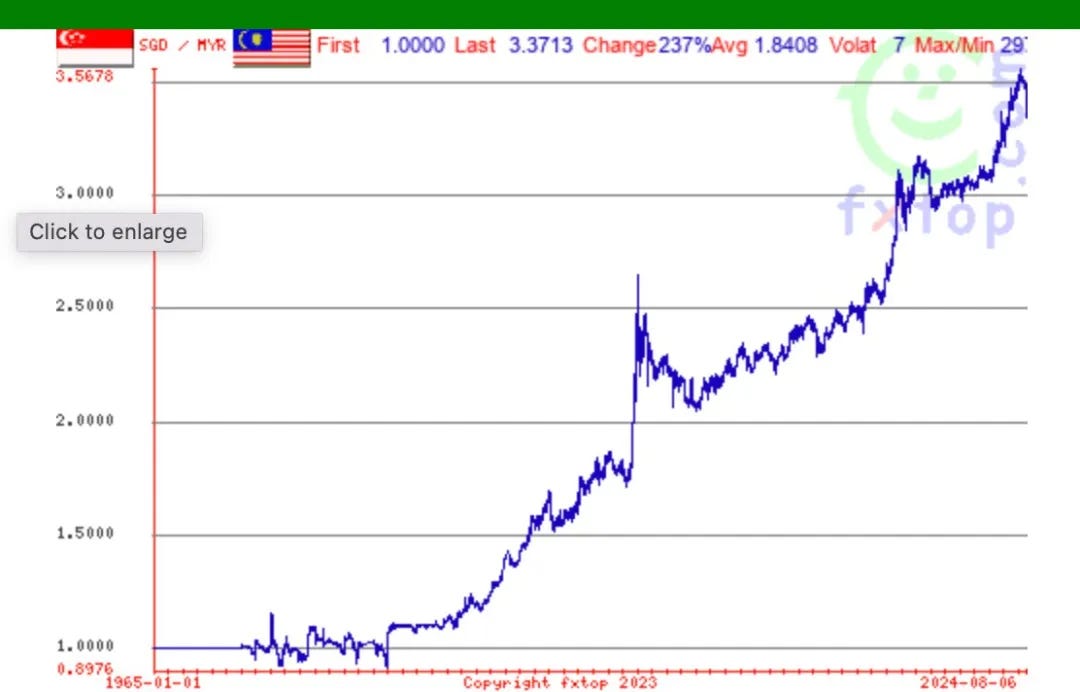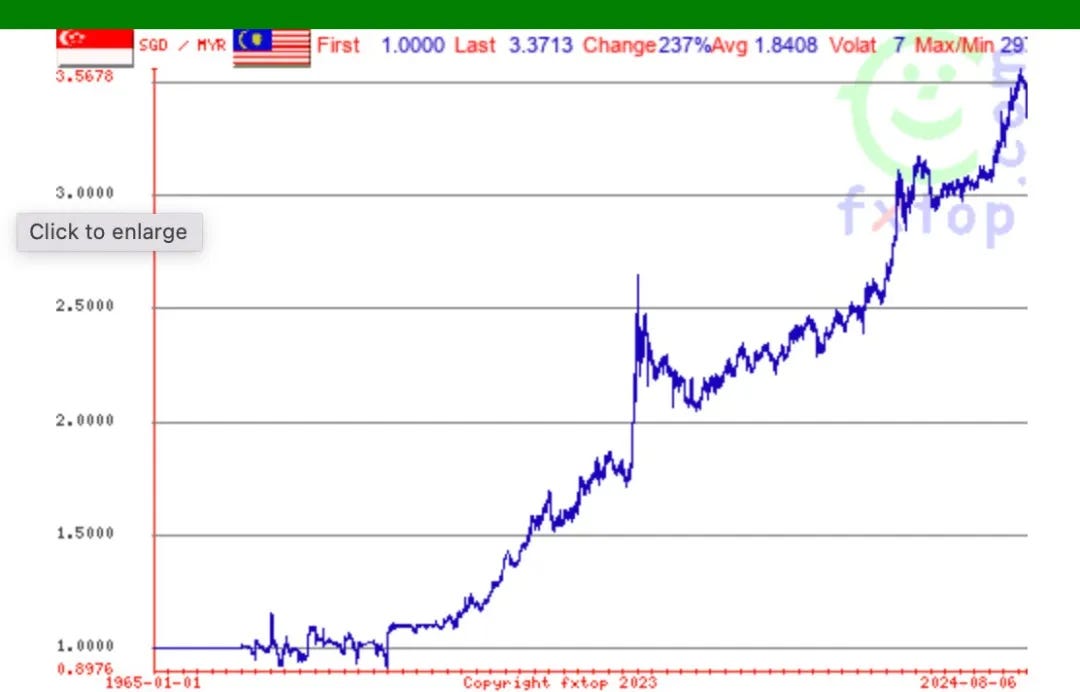Why the Singapore Dollar Keeps Rising (And What It Means) 为什么新币永远涨
This isn’t just about why the Singapore dollar (SGD) has strengthened during the interest rate hikes in recent years—it’s about why the SGD has been steadily appreciating for decades. A striking example is the SGD-MYR exchange rate: in 1980, one SGD equaled one MYR. Today, it’s 3.27.
A few years ago, the U.S. Treasury labeled Singapore as a “currency manipulator,” which, honestly, is a bit hilarious. After all, Singapore’s monetary policy is fundamentally designed to “manipulate” its exchange rate.
Unlike central banks in other countries, Singapore’s Monetary Authority (MAS) doesn’t set interest rates directly. Instead, it pegs the SGD to a basket of currencies.
The Managed Crawl
This currency basket, whose exact composition isn’t disclosed, is weighted based on Singapore’s trade relationships. It likely includes key currencies like the Malaysian Ringgit (MYR), U.S. Dollar (USD), and Chinese Yuan (CNY).
The MAS operates within a set policy band: it allows the SGD to fluctuate within this range in the short term but aims for gradual appreciation over the long term.
If the SGD stays within the band, MAS generally does nothing. But when it drifts out, MAS steps in—buying USD and selling SGD to curb appreciation or doing the reverse to support the SGD during depreciation.
Over the years, the SGD’s strength has usually forced MAS into buying USD and releasing SGD to prevent excessive appreciation. Why? It ties back to Singapore’s unique financial ecosystem.
Supply-Side Dynamics
The CPF System
Singapore’s Central Provident Fund (CPF) inherently reduces SGD supply. When employers contribute to CPF, a portion of wages—20% from employees and 17% from employers—is removed from circulation and channeled into long-term government investments via entities like GIC.
For example, an employee earning SGD 6,000 might see about SGD 2,000 deducted for CPF contributions. This money is essentially "frozen" in the system, limiting SGD liquidity.
Government Debt and Surpluses
Singapore issues government bonds but doesn’t use the proceeds for current spending. When people buy these bonds, the SGD effectively disappears from the market.
Similarly, fiscal surpluses—like collecting SGD 20 billion in taxes but spending only SGD 15 billion—are invested in reserves, further reducing SGD supply.
In 2007/08, CPF contributions and fiscal surpluses drained SGD 40 billion from the economy, while government debt absorbed another SGD 11 billion. MAS had to step in, selling SGD and buying USD worth over SGD 60 billion to balance the system.
Demand-Side Pressures
While supply-side constraints explain some of the SGD’s strength, the demand for SGD has been a major driver in recent years.
Foreign Investments: Companies setting up operations in Singapore must convert their capital to SGD.
Wealth Inflows: Global elites establishing family offices in Singapore also need SGD.
These factors fuel persistent demand, pushing the SGD upward. MAS’s foreign exchange reserves reflect this: even after selling USD during the 2022 rate hikes, reserves surged from SGD 388 billion to SGD 506 billion between 2023 and now, showcasing the immense pressure for SGD appreciation.
Why Not Devalue?
With Singapore's massive foreign reserves, the MAS has the ability to control the currency’s trajectory in the short to medium term. If they wanted to devalue the Singapore dollar, they could. The question, then, is not can they, but will they choose to devalue to stimulate exports during economic downturns?
The answer is unlikely. Singapore imports almost all its raw materials, and while devaluation might make exports cheaper, it would immediately drive up import costs and inflation. Rising production costs would quickly negate any competitive edge for exporters.
Instead, Singapore’s strategy focuses on maintaining a strong and stable currency, fostering steady growth, attracting external investments, and using USD gains for international investments that ultimately feed back into the local economy. For Singapore, devaluation isn’t just unnecessary—it’s counterproductive.
The Long-Term Reality
The above highlights a key limitation of Singapore’s monetary policy: it thrives in fair weather but struggles in a storm. When the economy is booming, foreign investments pour in, driving strong demand for the Singapore dollar, which appreciates steadily. The government can then convert that stronger currency into U.S. dollars for international investments, the returns of which help fund domestic spending.
But in a downturn? The playbook shrinks. With limited tools, the central bank’s main option is to dip into its foreign reserves to stabilize the economy. From this perspective, the SGD’s perpetual appreciation isn’t just a short-term reality—it’s more of an aspirational hope, a reflection of Singapore’s long-term confidence in its economic resilience, which might lean a little too much on optimism.
(Disclaimer: This article was originally written in Chinese and translated into English by the almighty ChatGPT with some manual editing. In case of any discrepancies, the original Chinese version should be considered the preferred source. Below is the Chinese version)
这篇要说的,不仅是为什么最近这轮加息周期新币一直升值,而是为什么过去几十年,新币(几乎)一直在升值。最明显的例子,是新马之间的汇率,在1980年还是1比1,但几十年过去,汇率已是3.36
几年前美国财政部出过一个报告,将新加坡列入了操纵汇率的观察名单——这事其实挺无厘头的,因为新加坡的货币政策,本质上就是“操纵”汇率
和其他国家的央行不一样,新加坡的金管局MAS并不直接设定/影响利率水平,而是将新币和一篮子货币挂钩
这一篮子货币的成分,没有明确公开,但主要是依据和新加坡的贸易额来确定权重的。比如可以想象,大马的令吉、美元、人民币在这个篮子里应该都有重要的地位
以这一篮子货币为基础,新加坡的货币政策,是短期内确保新币在某个区间(band)内波动,而中长期实现缓慢升值(crawl)
如果新币汇率在既定的区间内波动,金管局一般不干预。而一旦滑出区间,金管局则会直接进场,将汇率拉回既定的水平。具体来说,如果新币升值过快,金管局会在市场上买入美元,卖出新币。如果贬值过快,则会买入新币,卖出美元
在过去几十年,虽然这两种操作都有,但长期来看,更常见的情况是新币升值太快,以至于金管局不得不买入美元,释放更多新币抑制新币增值。这背后的原因,和新加坡几大「基础设施」有关
首先,公积金制度的设定,本身会减少新币供给。一个雇员的工资假设6000块(雇主每月总支出是6000+17%),这7K在发工资之前,本来是躺在公司银行账户的活钱,但是当缴纳完CPF后,雇主少了7K,而员工到手也只有5K,剩下的2K「暂时」退出了市场,被政府用来做长期投资(GIC)
其次,在新加坡,政府虽然也发债,但发债所得不能用于当期的财政支出。人们用新币买了政府债券(比如十年期国债),这一笔新币就从市场消失了。类似的还有政府的财政盈余。比如今年收了2000亿税,但只支出了1500亿,盈余的500亿不能无限carry forward,而必须放到国库进行长期投资。这个过程,也是减少新币供给的过程
以2007/08财年为例,当年CPF 和财政盈余使得新币流动性减少了400亿新元,发债使得新币供给减少了110亿新元。要知道,2008年的M2只有3000亿左右。为了抑制新币上涨,金管局做了相应的换汇操作,卖出新币,买入了相当于600多亿新币的美元
换得的外汇储备,会通过GIC进行投资。而投资所得的一部分,会汇入每年的财政收入。事实上,每年的投资所得,已经超过了任何单一税种(比如GST和公司税)的收入
当然,上面的这些,是不能长期持续的。比如,交CPF固然减少了新币流动性,但从CPF领钱,恰恰是相反的效果。随着老龄化程度加剧,缴纳和支取终会达到一个平衡。另一方面,随着经济增长的放缓,大量的财政盈余似乎已经是很久以前的故事了
但除此之外,还有一个重要因素没有提及。上面讲的都是新币的供给面的因素。过去十年新币的强劲增长,主要还是需求面在起作用:资本对新币的强劲需求,是新币持续升值的重要基础。外国公司在新加坡进行固定投资,得换新币;富豪来新加坡开设家庭办公室,也得换新币。这些需求都会刺激新币增值。
如果看近几年新加坡外汇储备的数字,会发现新币的升值压力是如此之大,以至于政府需要不断出手卖出新币买入美元。除了 2022 年由于美国罕见的暴力加息,新加坡金管局卖出不少美元导致外汇储备有所下降之外,大部分时间里金管局的操作都是买美元,卖新币。从 2023 年到现在的一年半时间,外汇储备就从 3882 亿涨到了 5064 亿,基本回到了加息前的水平
这些天量外汇储备,说明了至少在中短期,政府完全有能力实现自己的政策目标,想升值就升值。那么最后需要问的问题,就是政府有没有意愿让新币一直升值。换句话说,会不会像一些国家一样,通过贬值来刺激出口?
对于新加坡来说,货币主动贬值的可能性非常小。新加坡几乎一切生产原材料都靠进口,贬值固然降低了出口价格,但是也增加了进口价格。货币贬值几乎会立刻推高通胀,而原材料都变贵的情况下,出口价格也很难真正降下来
这也说明在逆境时,新加坡政策的操作空间非常小。经济顺风顺水时,有外来投资,新币需求强劲,稳步增值,换出来的美元又可用于国际投资,反哺国内财政。但是当经济衰退时,起码在货币政策上,除了消耗外汇储备,办法并不多。从这个角度来看,新币永远涨不仅是一种中短期的现实,也是一种对国运的长期(盲目)乐观主义




